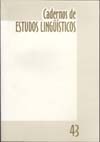Resumen
Num estudo recente, Barbosa sugere que, para uma síntese de fala com naturalidade, o número de sílabas no grupo acentual poderia ser determinado dinamicamente a partir das relações momentâneas dos osciladores acentual e silábico. Consideramos aqui as ramificações desta idéia para entender padrões na fala natural, utilizando e estendendo um modelo de osciladores acoplados hierarquizados previamente desenvolvido.Citas
AGRESTI, Alan (1990). Categorical Data Analysis. New York: John Wiley & Sons.
BARBOSA, Plínio A. (2000). “Syllable-timing in Brazilian Portuguese”: uma crítica a Roy Major. D.E.L.T.A. (16) 2: 369–402.
BARBOSA, Plínio A. (2001). Generating duration from a cognitively plausible model of rhythm production. Proceedings of the Seventh European Conference on Speech Communication and Technology (Eurospeech 2001). Aalborg, Denmark, September 3–7. v. 2: 967–970.
BHAT, U. Narayan (1972). Elements of Applied Stochastic Processes. New York: John Wiley & Sons.
ERIKSSON, Anders (1991). Aspects of Swedish Speech Rhythm. Department of Linguistics, University of Göteborg.
FANT, G.; KRUCKENBERG, A. (1989). Preliminaries to the study of Swedish prose reading and reading style. Quarterly Progress and Status Report, Speech Transmission Laboratory, KTH. 2: 1–83.
GILKS, W.R.; RICHARDSON, S.; SPIEGELHALTER, D. J. (eds.) (1996). Markov Chain Monte Carlo in Practice. London: Chapman and Hall.
HAKEN, Hermann (1983). Synergetics: An Introduction. New York: Springer-Verlag.
KARLSSON, Fred (1983). Finnish Grammar. Juva: WSOY.
KOPELL, Nancy (1988). Toward a theory of modelling central pattern generators. A. H. COHEN; S. ROSSIGNOL; S. GRILLNER (eds.) Neural Control of Rhythmic Movement in Vertebrates. New York: John Wiley & Sons. pp. 369–413.
NIEMINEN, Tommi (1996). Suomen kielen puherytmi. Unpublished pro gradu thesis. Department of Finnish language and general linguistics, University of Tampere, Finland.
O’DELL, Michael L. & NIEMINEN, Tommi (1998). Reasons for an underlying unity in rhythm dichotomy. Proceedings of the Finnic Phonetics Symposium. August 11–14, 1998. Pärnu, Estonia. Linguistica Uralica XXXIV. 3: 178–185. Available at: http://www.uta.fi/~sktoni/tiede/odell-nieminen98.pdf.
O’DELL, Michael L. (1999). Coupled oscillator model of speech rhythm. Proceedings of the XIVth International Congress of Phonetic Sciences, San Francisco. 1–7 August. v. 2. pp. 1075–1078. Available at: http://www.uta.fi/~sktoni/tiede/odell-nieminen99.pdf.
O’DELL, Michael L. (2001). Speech rhythms as cyclical activity. STIINA Ojala ; Jyrki TUOMAINEN (ed.): 21. Fonetiikan päivät. Turku 4.–5.1.2001. Turun yliopiston suomalaisen ja yleisen kielitieteen laitoksen julkaisuja 67. Turku 2001. 159–165. Available at: http://www.uta.fi/~sktoni/tiede/odellnieminen01.pdf.
PORT, Robert F.; VAN GELDER, Timothy (eds.) (1995). Mind as Motion. Explorations in the Dynamics of Cognition. Cambridge, Mass.:The MIT Press.
PRIGOGINE, Ilya (1997). The End of Certainty: Time, Chaos, and the New Laws of Nature. New York: The Free Press.
SPIEGELHALTER, D. J.; THOMAS, A; BEST, N. G. & GILKS, W. R. (1996). BUGS: Bayesian inference Using Gibbs Sampling, Version 0.5, (version ii). MRC Biostatistics Unit, Cambridge.
Se otorgan a la Revista CADERNOS DE ESTUDOS LINGÜÍSTICOS todos los derechos de autor relativos a los trabajos publicados. No se devolverán los originales. En virtud de su aparición en esta revista de acceso abierto, los artículos son de uso gratuito, con la debida atribución, en aplicaciones educativas y no comerciales.

